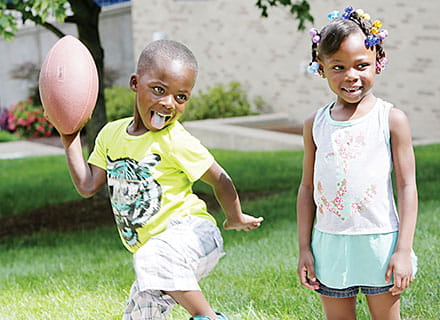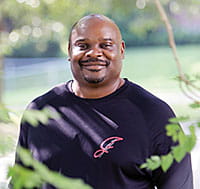Experts at Cincinnati Children’s Partner to Find the Best Treatments, Cures for Asthma

Both Kayne and his sister Mykaylah were diagnosed with a life-threatening medical condition. The two, along with their mother and other family members, suffer from asthma and must watch their physical activity, exposure to heat, humidity and pollution to stay healthy.
As brother and sister, Mykaylah and Kayne couldn’t be more different. At 4 years old, Mykaylah is quiet and reserved, while 3-year-old Kayne has never met a stranger.
Their personalities and interests are opposites, but Mykaylah and Kayne hold one thing in common, not just with each other, but with 7 million other children – they suffer from asthma, a chronic illness that causes airways to become narrowed or obstructed. On particularly hot or humid days, the siblings, and others like them, won't be found at the neighborhood playground. Instead, they'll be inside, where the air is safe to breathe, and less likely to cause an asthma attack.
Their mom, Unique, knows firsthand what her kids are going through – she suffers from asthma as well, and is familiar with the risks and symptoms of this disease.
“It’s like having a bag over your head,” she says. Others have described asthma attacks as feeling tightness in their chest or feeling like they are breathing through a straw. “It’s terrifying,” Unique adds. “When the attacks are severe, you panic and wonder, Is this how I am going to die?”
Asthma is known to be caused by environmental factors, but genetics can also be a factor. In fact, research has shown that if a child has a family member with asthma, he or she is three to six times more likely to suffer from the condition.
Unique was not aware that genetics could play a role until she noticed Mykaylah, then just 11 months old, struggling to breathe. She immediately sought guidance from the experts at Cincinnati Children’s where Mykaylah was diagnosed with asthma. Unique recognized the same symptoms in Kayne when he was just 3 months old and immediately had him tested. Our experts confirmed that he too battles this chronic condition.
With two children suffering from asthma, it was important to Unique that she understand what factors could trigger an attack and when it was most likely to happen. She learned that outdoor allergens are the most common, but environmental irritants such as mold, dust mites and animal dander – all commonly found in the home – can also cause attacks, particularly in late summer and early fall.
For Mykaylah and Kayne, seasonal changes aren’t the only triggers – as residents of downtown Cincinnati, smoke, exhaust and road dust also aggravate their condition. Because of these environmental factors, the siblings have found themselves in Cincinnati Children’s emergency department (ED) more than 10 times over the last three years, with admissions lasting a few days.
“Most of the time, we are able to control their asthma,” Unique says. “But when it’s severe, there’s no hesitation – we go straight to the medical center because we know Cincinnati Children’s is where they will receive the best care.”
Preventative Care to Improve Lives
Experts in Cincinnati Children’s ED see asthma-related emergencies almost daily.
“Many of the children with asthma who visit the medical center live within the urban core of Cincinnati,” says Carolyn Kercsmar, MD, director of the Asthma Center in the Division of Pulmonary Medicine at Cincinnati Children’s. “The irritants that will trigger an attack are all around them, 24 hours a day.”
“It’s hard to avoid,” Kercsmar adds, “but we’ve taken strategic steps to help kids with asthma live happier, healthier lives.”
While a cure has yet to be found, preventative measures have been shown to dramatically decrease the number of incidents for children suffering from asthma throughout Cincinnati.
Kercsmar and her team, in collaboration with teams from general pediatrics, hospital medicine, and home health care at Cincinnati Children’s, have tackled this problem head-on by implementing new home-based initiatives that help to reduce the number of asthma-related trips to the emergency department.
These initiatives help families better manage their child’s condition. From home delivery of medications to partnering with school health workers to ensure consistent treatment throughout the day, our experts are stepping outside the walls of the medical center to help kids with asthma stay healthy and reach their full potential.
The program is working – the rate of ED visits by the targeted population has decreased by 36 percent since the initiative began.
“We have experienced a dramatic decrease in the number of emergency asthmatic-episodes,” Kercsmar says. “The key was prevention through close medical follow-up, care coordination, education, awareness and collaboration – we’ve made great strides.”
Making a Difference
 Asthma education and awareness has a strong champion in Ickey Woods. The former Cincinnati Bengals running back is a generous supporter of our work in asthma research and preventative care.
Asthma education and awareness has a strong champion in Ickey Woods. The former Cincinnati Bengals running back is a generous supporter of our work in asthma research and preventative care.
Despite living with asthma, Ickey’s son, Jovante, was an accomplished student-athlete. As a starting cornerback on the varsity football team and a star performer on his school’s track team, Jovante averaged a 3.8 GPA and had dreams of becoming an attorney.
“Jovante was an outstanding young man,” says Ickey. “Everyone loved him.”
On a hot and humid day, hours after coming home from football practice, Jovante complained that he couldn’t breathe and suddenly collapsed. His brother ran for help, but by the time the emergency medical team arrived and airlifted him to Cincinnati Children's, he had gone without oxygen for at least 30 minutes.
Three days later, Javonte passed away.
After losing his son to asthma, Ickey was driven to help find a cure and to educate the Cincinnati community and beyond on the effects of asthma in hopes of preventing others from experiencing the pain his family endured.
“My new focus in life is to make a difference,” Ickey added. “I don’t want families to go through the devastation of losing their child to asthma.”
That’s why he has generously funded critical research being performed by Gurjit “Neeru” Khurana Hershey, MD, PhD, director of asthma research at Cincinnati Children’s.
Advancing Treatments, Increasing Awareness
Improving care and increasing asthma awareness is a shared goal between Ickey and Hershey. Her research focuses on the triggers of asthma and developing new treatments for children with the disease.
With thousands of deaths each year due to severe asthmatic episodes, the work performed by Hershey’s team is critical.
“There is a misconception that asthma is asthma,” says Hershey. “But in reality, the condition is different for each person. It’s important that we identify new treatments so we can help those kids suffering from this disease live healthier, fuller lives.”
The generosity of donors, like Ickey Woods, has made a tremendous impact – helping us build relationships and educate community members about the triggers and effects of asthma. What’s more, his support has allowed the team at Cincinnati Children’s to further expand our research efforts and advance care for those suffering from the disease.
Working Toward a Cure, One Generous Donor at a Time
Despite the incredible advances made by researchers and physicians at Cincinnati Children’s in the treatment and prevention of asthma, there is more work to be done, more children to free from this chronic disease.
Kids suffering from asthma, like Mykaylah and Kayne, can breathe a sigh of relief knowing that generous donors continue to partner with the experts at Cincinnati Children’s to identify prevention strategies and discover life-saving treatments.
“My hope is that one day there is a cure – not only for my kids, but for the millions of kids who deal with asthma every day,” says Unique. “If there is any hospital in the country that can find it – it’s Cincinnati Children’s.”
How to Help
To learn more or support our asthma care and research, contact Marianne Requarth at 513-636-1166 or marianne.requarth@cchmc.org.



